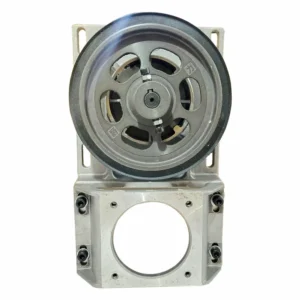Overview:
- Type: Helical Rack
- Primary Function: Converts rotational motion from a helical pinion into linear motion, providing smooth and accurate movement along a linear path.
Key Features:
- Construction and Materials:
- Material: Typically made from high-strength materials such as steel, stainless steel, or aluminum. Steel is common for heavy-duty applications due to its durability and load-bearing capacity.
- Design: Features helical teeth cut at an angle to the rack’s axis. This helical design allows for smoother engagement with the pinion compared to straight-cut racks.
- Gear Teeth:
- Helical Teeth: The teeth of the helical rack are cut at a specific angle relative to the axis of the rack. This angle allows for gradual engagement of the teeth with the pinion, reducing noise and vibration.
- Pitch and Module: The pitch (distance between adjacent teeth) and module (size of the teeth) are standardized to ensure compatibility with helical pinions. These parameters determine the precision and load capacity of the rack.
- Mounting and Installation:
- Mounting: Typically mounted onto a fixed surface using bolts or other fastening methods. Accurate alignment with the helical pinion is crucial for proper operation.
- Installation: The rack must be aligned parallel to the motion path to ensure smooth and accurate linear motion. Proper installation is essential to avoid excessive wear or misalignment.
- Performance Characteristics:
- Smooth Operation: The helical tooth design reduces noise and vibration compared to straight racks, resulting in smoother and quieter operation.
- Load Capacity: Capable of handling high loads and providing reliable performance in demanding applications.
- Applications:
- CNC Machines: Used to drive the movement of the machine’s axes, providing precise control over cutting or engraving operations.
- Industrial Automation: Employed in automated systems for linear motion tasks, such as conveyor systems and robotic arms.
- Robotics: Utilized in robotic systems for accurate and controlled linear movement.
- Material Handling: Found in systems that require precise and reliable movement of materials or components.
- Advantages:
- Reduced Noise: The helical design minimizes noise and vibration during operation, contributing to a quieter and more pleasant working environment.
- Smooth Engagement: Provides smooth and continuous engagement with the pinion, enhancing motion accuracy and reducing wear.
- Higher Load Capacity: The helical teeth design allows for higher load capacity and better load distribution compared to straight racks.
- Maintenance:
- Inspection: Regular inspection for wear, alignment, and damage is important to maintain optimal performance.
- Lubrication: Proper lubrication of the helical teeth is necessary to reduce friction and extend the lifespan of the rack and pinion system.
- Cleaning: Keeping the rack and pinion clean from debris and contaminants helps prevent damage and ensures smooth operation.
- Customization:
- Length and Size: Helical racks can be customized in terms of length, width, and thickness to meet specific application requirements.
- Tooth Profile: The tooth profile can be tailored to match the needs of the application, such as varying pitch and module sizes.
Benefits:
- Enhanced Precision: Provides precise linear motion, which is crucial for applications requiring high accuracy and repeatability.
- Reduced Wear: The helical design helps distribute load more evenly across the teeth, reducing localized wear and extending the service life.
- Increased Efficiency: Smooth and efficient power transmission contributes to overall system efficiency and performance.






Reviews
There are no reviews yet.